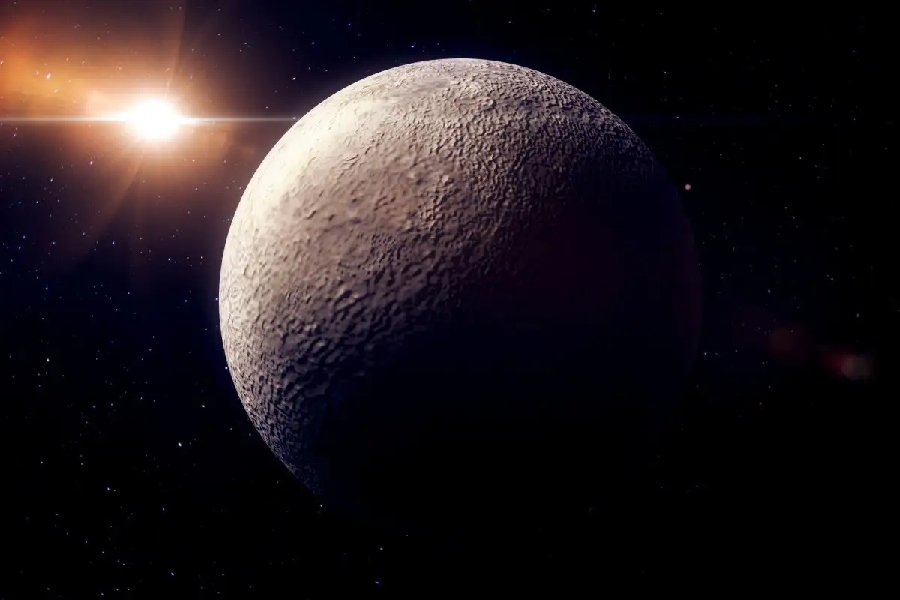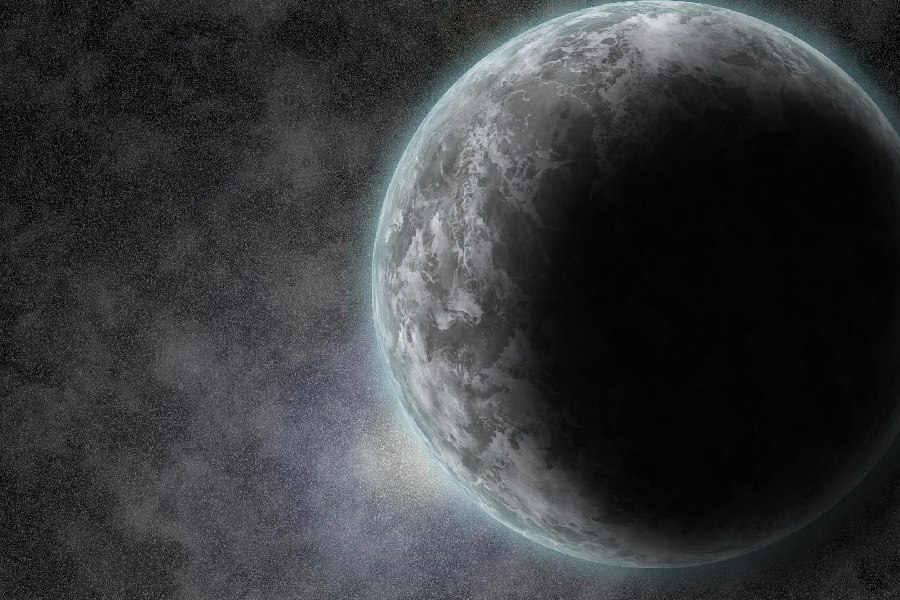A mysterious icy world far beyond Pluto called Quaoar was discovered only in the early 2000s. This small, frozen orb hiding in the frigid outskirts of our solar system defied categorization when first spotted. But what is Quaoar? How many moons does Quaoar have?
In this article, we’ll demystify Quaoar and explain what it is. We’ll look at when and how it was found, its unusual orbit, composition, and size. We’ll cover what makes icy worlds like Quaoar different from asteroids or comets.
Read on to uncover the Quaoar facts!
What Is Quaoar?
Quaoar is a trans-Neptunian object (TNO) located in the Kuiper Belt, a region of the outer Solar System beyond Neptune. Discovered in 2002, Quaoar is considered a dwarf planet, and it is one of the largest known objects in the Kuiper Belt. It has a diameter of approximately 680 miles (1,090 kilometers) and orbits the Sun in a distant and elongated path.
The discovery of Quaoar provided insights into the population of small, icy bodies in the outer solar system. It also contributed to understanding how objects in this distant region formed and evolved over time.

Discovery, naming, and classification
The discovery of Quaoar was a pivotal moment in our grasp of the outer solar system. It didn’t happen by chance but resulted from a committed quest for objects beyond Neptune, known as trans-Neptunian objects (TNOs).
Astronomers had long suspected the presence of a vast icy expanse beyond the gas giants, prompting a focused search for TNOs in the late 20th century. Finally, in 2002, astronomers Michael Brown and Chad Trujillo made a breakthrough using a powerful telescope at the Palomar Observatory.
Through their observations, they uncovered a faint, distant object, later named 50000 Quaoar. This discovery contributed to the growing list of known TNOs, including the dwarf planet Pluto.
A name rooted in mythology
Initially known only by its numerical designation, assigning an official name became essential for effective scientific communication. After thorough deliberation, the International Astronomical Union (IAU) chose “Quaoar.” This name draws from the creation myth of the Tongva people, who are indigenous to southern California.
According to their mythology, Quaoar is the deity responsible for creating the sky and heavens. This selection resonates with the celestial characteristics of the object and pays homage to the cultural legacy of the area in which it was first identified.
The debate: A dwarf planet or something more?
After the discovery of Eris, a larger object than Pluto, in 2005, the International Astronomical Union (IAU) created a new category known as “dwarf planet”. For an object to be classified as a dwarf planet, it must orbit the Sun, have enough mass for its gravity to make it round, and not have cleared its orbital path of other objects.
While Quaoar meets the first two criteria, its orbit slightly overlaps with Neptune’s, meaning it hasn’t entirely cleared its orbital neighborhood. This aspect has sparked debate within the scientific community, with some suggesting that Quaoar should be reclassified as a large Kuiper Belt object (KBO) rather than a dwarf planet.
Quaoar’s considerable size and nearly spherical shape support its classification as a dwarf planet. This reflects the ongoing evolution in our understanding of celestial bodies within the solar system.
Quaoar’s Characteristics and Classification
Unveiling key attributes
Quaoar is quite big, measuring about 680 miles (1,090 kilometers) in diameter. It ranks among the largest objects in the Kuiper Belt, a vast area filled with icy bodies beyond Neptune. Its size is similar to Saturn’s moon, Dione, and about half the size of Pluto.
Due to its nearly spherical shape and considerable mass, Quaoar has a strong gravitational influence in its orbit within the Edgeworth-Kuiper Belt. Its mass allows it to maintain a rounded shape unless it collides with other sizable Kuiper Belt Objects (KBOs), which could disrupt its equilibrium.
A glimpse into the surface
Observations from telescopes and spacecraft suggest that Quaoar’s surface is mainly made of water ice, with traces of other frozen substances like ammonia and methane. However, Quaoar’s vast distance from Earth constrains our understanding of its surface features.
According to models, crystalline ice covers the high and mid-latitudes of Quaoar. In contrast, amorphous ice dominates the lower regions. The heating and cooling cycles cause the ice to thaw and refreeze in these areas.
Consequently, solar-driven seasonal changes occur around Quaoar’s poles. These changes result in distinct morphological regions characterized by the two primary types of ice.

Quaoar: A Dwarf Planet in the Spotlight
Despite some debate surrounding its orbital path, Quaoar fulfills two of the key criteria for classification as a dwarf planet. It orbits the Sun and possesses sufficient mass to be in hydrostatic equilibrium, meaning its own gravity pulls it into a nearly spherical shape.
Standing out in the crowd
Quaoar stands out among other big Kuiper Belt objects because of its spherical shape and size. Adding to its credentials as a dwarf planet is that it has a moon called Weywot, which some larger KBOs don’t have.
However, the ongoing debate over Quaoar’s exact orbit shows how tricky it can be to categorize objects in the outer reaches of our Solar System. As we keep learning more and making discoveries, our grasp of Quaoar and where it fits in the cosmic scheme will keep changing.
Does Quaoar Have Rings?
Quaoar, unlike the massive outer planets, doesn’t showcase any visible ring system. Despite efforts to detect rings or satellites around Quaoar, none have been found thus far. However, some astronomers speculate that rings might be present, albeit at an incredibly faint or tenuous level.
The possibility of rings around Quaoar remains uncertain. Situated in a region where occasional collisions can still occur over vast astronomical timescales, Quaoar could potentially witness such impacts that give rise to extremely subtle debris rings.
To conclusively determine the existence of rings around Quaoar, further observations utilizing next-generation telescopes may be necessary. These advanced instruments could resolve the ongoing debate regarding Quaoar’s ring system.
Quaoar’s Orbital Journey
Understanding Quaoar’s position within the Solar System requires examining its unique orbital characteristics. As mentioned, Quaoar resides in a region beyond the gas giants, known as the Kuiper Belt. This vast icy realm is a treasure trove of trans-Neptunian objects (TNOs), and Quaoar occupies a unique position within it.
Quaoar orbit takes it on a lengthy celestial dance around the Sun. Unlike Earth’s near-circular orbit, Quaoar’s path is slightly elliptical, meaning its distance from the Sun varies throughout its journey.
Precise measurements: Distance and orbital period
On average, Quaoar resides at a distance of approximately 43.7 Astronomical Units (AU) from the Sun. An AU is the average distance between Earth and the Sun, making Quaoar over 40 times farther away than Earth. This vast distance translates to sunlight taking over five hours to reach its surface, compared to only eight minutes for Earth.
A journey lasting years
Due to its distance and elliptical orbit, Quaoar takes a significantly longer time to complete one full revolution around the Sun, known as its orbital period. This journey takes approximately 288 Earth years, meaning a single “Quaoarian year” is equivalent to almost three centuries on Earth.
The combination of its great distance and extended orbital period exposes Quaoar to a harsh environment with extreme temperatures and limited sunlight. This shapes its physical characteristics and influences its celestial dance within the vastness of our Solar System.
Conclusion
What is Quaoar? As we conclude our voyage to this mysterious outpost named Quaoar, we hope uncovering its discovery sequence and classifying attributes has brought an intriguing Kuiper Belt denizen into brighter focus.
Understanding its existence deepens the appreciation for the diversity of our Solar System, where small worlds hold immense significance and defy easy categorization. Quaoar embodies a paradox. It exists as an icy realm with a possible hidden ocean.
This blurs the lines between what we classically define as a Kuiper Belt Object and a dwarf planet. Quaoar is a celestial traveler defined by its past and an uncertain future. It is one of countless worlds sharing our solar system’s journey.
